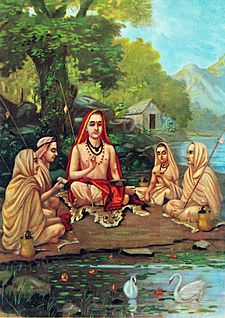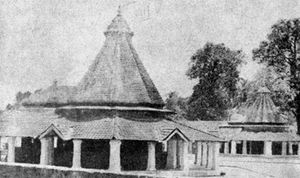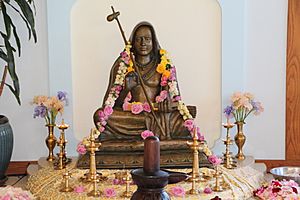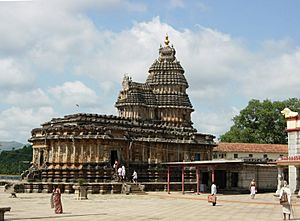Adi Shankara facts for kids
Quick facts for kids {{{name}}} |
|
|---|---|

Painting of Adi Shankara, exponent of Advaita Vedanta with his disciples by Raja Ravi Varma
|
|
| Birth Date | c. 700 CE (disputed) Kalady, Chera Kingdom (present-day Kochi in Kerala, India) |
| Died on | c. 750 CE (disputed) Kedarnath, Gurjara-Pratihara Empire (present-day Uttarakhand, India) |
| Birth name | Shankara |
| Guru/teacher | Govinda Bhagavatpada |
| Philosophy | Advaita Vedanta |
| Titles/honors | Jagadguru |
Adi Shankara (pronounced Ah-dee Shan-kah-rah) was a very important Indian thinker and teacher. He lived a long time ago, probably in the 700s CE. People also call him Adi Shankaracharya. He was a Vedic scholar, which means he studied ancient Indian texts called the Vedas.
Adi Shankara taught about a philosophy called Advaita Vedanta. This teaching helps people understand themselves and the world around them. He wrote many books and commentaries, explaining his ideas. He also traveled a lot, sharing his wisdom and debating with other scholars.
Over time, Adi Shankara became very famous. Many stories and legends were written about him. He is seen as someone who helped bring different parts of Hinduism closer together. He also helped set up important monasteries, called mathas, across India.
When Did Adi Shankara Live?
It's a bit tricky to know the exact dates of Adi Shankara's life. The stories about him were written many centuries after he lived. They mix facts with legends.
- Most modern experts think he lived for about 32 years, sometime between 700 CE and 750 CE.
- Some older records suggest he lived earlier, around 500 BCE.
- Other ideas place him in the late 700s or early 800s CE.
But the most common belief today is that he was a scholar from the first half of the 8th century CE.
Adi Shankara's Writings
Adi Shankara's writings are the foundation of the Advaita Vedanta school of Hinduism. His ideas have greatly influenced modern Indian thought. More than 300 texts are said to be written by him. These include commentaries, philosophical explanations, and poems.
However, many of these texts were likely written by his followers or other scholars with similar names. Only a few are definitely known to be his own work.
His Main Books
Adi Shankara is best known for his detailed explanations of ancient Indian texts. His most important commentary is the Brahmasutrabhasya. This book explains the Brahma Sutra, a key text in the Vedanta tradition.
He also wrote commentaries on ten important Upanishads. These are ancient spiritual texts. Some of these include:
- The Brihadaranyaka Upanishad
- The Chandogya Upanishad
- The Isha Upanishad
- The Katha Upanishad
Another authentic work is his commentary on the Bhagavad Gita. This is a famous Hindu scripture. He also wrote an original philosophical book called Upadesasahasri. This book contains a thousand teachings.
Adi Shankara also wrote poems. Some of his authentic poems are dedicated to different Hindu gods, like Krishna and Shiva. These poems show that he believed all gods are different forms of the one ultimate reality.
Books Not Fully His
Some books are thought to be written by Adi Shankara, but experts are not sure. For example, the Vivekacudamani is a very popular book about his teachings. However, some scholars doubt if he actually wrote it. It's still very important for understanding his ideas.
Other commentaries and philosophical writings are also believed to be by later scholars, not Adi Shankara himself.
Adi Shankara's Philosophy
Adi Shankara was a great thinker who brought together ideas from earlier philosophers. His main teaching is that your true self, called Atman, is the same as the ultimate reality, called Brahman. He taught that understanding this truth brings freedom and happiness.
What is Advaita?
Adi Shankara helped organize and explain the Advaita Vedanta philosophy. "Advaita" means "not two" or "non-dual." It teaches that everything seems separate, but deep down, it's all one.
He believed that the world we see, with all its differences, is not completely real in the highest sense. It's like a dream or an illusion, called Maya. The only true reality is Brahman, which is pure consciousness and existence.
Finding Freedom (Moksha)
According to Adi Shankara, the goal of life is to achieve Moksha. This means becoming free from suffering and the cycle of rebirth. You achieve this by realizing that your Atman (your soul) is exactly the same as Brahman (the ultimate reality).
He taught that this understanding comes from deep study and reflection, especially on the Upanishads. He said:
I am other than name, form and action.
My nature is ever free!
I am Self, the supreme unconditioned Brahman.
I am pure Awareness, always non-dual.
This means that your true self is not your body, your name, or your actions. It is pure, free, and one with everything.
How We Gain Knowledge
Adi Shankara thought that we gain knowledge in different ways. He believed that direct experience and logical thinking are very important. If you can figure something out by seeing it or thinking about it, you don't always need to look it up in religious texts.
However, for big questions about life, like what happens after death or the nature of God, he said that ancient scriptures like the Vedas and Upanishads are very helpful. He also stressed the importance of a good teacher (Guru) to guide students.
He taught that to truly understand, you need to use both logic and the wisdom from ancient texts. He also said that a pure and calm mind, like the one you get from Yoga, helps you understand these deep truths.
The Great Sayings (Mahavakyas)
Adi Shankara focused on certain powerful statements from the Upanishads. These are called Mahavakyas (Great Sayings). They reveal the oneness of Atman and Brahman.
Four of the most important Mahavakyas are:
- तत्त्वमसि (tat tvam asi): "That you are." This means your true self is the ultimate reality.
- अहं ब्रह्मास्मि (aham brahmāsmi): "I am Brahman." This means your true self is the Divine.
- प्रज्ञानं ब्रह्म (prajñānam brahma): "Consciousness is Brahman." This means ultimate reality is pure consciousness.
- अयमात्मा ब्रह्म (ayamātmā brahma): "This Atman is Brahman." This means your soul is the ultimate reality.
These sayings help people realize that their individual self is not separate from the universal reality.
Giving Up Rituals
Adi Shankara taught that once you truly understand the oneness of Atman and Brahman, you don't need to perform many religious rituals anymore. Rituals are good for preparing the mind and purifying it. But true freedom comes from knowledge, not just from doing rituals.
He believed that thinking "I am different from God" is a mistake. When you realize you are one with Brahman, the need for rituals that treat God as separate goes away.
However, he also said that living an ethical life is very important. Being kind, honest, and non-violent helps purify the mind. This makes it easier to gain true knowledge.
Similarities with Buddhism
Adi Shankara's ideas have some similarities with Mahayana Buddhism. Because of this, some people even called him a "crypto-Buddhist," meaning a hidden Buddhist.
However, there are also important differences. One main difference is about the "Self."
- Buddhism often teaches that there is no permanent "Self" (called Anatta).
- Adi Shankara's Advaita Vedanta teaches that there is a true, eternal Self (Atman), which is the same as Brahman.
So, while both philosophies aim for freedom from suffering, they have different ideas about the nature of reality and the self.
Adi Shankara's Impact
Adi Shankara had a huge impact on Hinduism. He lived during a time when India was politically unstable. Many different religious groups were competing. Buddhism was also very strong.
Traditional Beliefs About His Influence
Many Hindus believe that Adi Shankara helped bring back the study of the Vedas. They see him as someone who defended Hindu traditions against other philosophies, like Buddhism and Jainism.
He is also traditionally credited with uniting different Hindu groups, like those who worshipped Vishnu, Shiva, or Devi. He taught that all these gods are just different forms of the one ultimate Brahman. He is said to have started the Panchayatana puja, where people worship five main deities at once.
Adi Shankara is also believed to have organized Hindu monks into ten groups, called the Dashanami Sampradaya. He is said to have founded four main monasteries (mathas) in different parts of India:
- Dvārakā in the West
- Jagannatha Puri in the East
- Sringeri in the South
- Badrikashrama in the North
These monasteries are still very important centers of learning and spiritual practice today.
Modern Views on His Influence
Some modern scholars question how famous Adi Shankara was during his own lifetime. They say he might not have been widely known for a few centuries after his death. Other philosophers were more influential at that time.
His fame really grew much later, especially from the 14th century onwards. This was partly due to the support of kings from the Vijayanagara Empire. Scholars like Vidyaranya helped spread his teachings and wrote stories about his travels and debates across India. These stories made him a very important figure in Hindu history.
In the 19th and 20th centuries, Western scholars and modern Hindu thinkers further promoted Advaita Vedanta. They saw it as a key philosophy that connected all of Hinduism.
Adi Shankara's Life Story
The stories about Adi Shankara's life are often filled with legends. They were written many centuries after he lived.
He was born in a village called Kalady in the southern Indian state of Kerala. His parents were a devout couple who had no children for a long time. They named him Shankara, which means "giver of prosperity." His father passed away when Shankara was very young.
From a young age, Shankara wanted to become a Sannyasa (a renunciate or monk). His mother did not want him to. A famous story tells how, when he was eight, a crocodile caught him while he was bathing in a river. Shankara told his mother that the crocodile would only let him go if she allowed him to become a Sannyasin. His mother agreed, and he was freed.
After this, he left home to find a teacher. He became a student of Govinda Bhagavatpada. He studied the Vedas, Upanishads, and other important texts with his teacher. Many stories describe him traveling all over India, debating with other scholars and spreading his philosophy.
He had several important students who also became famous scholars. These included Padmapadacharya and Sureśvaracharya.
Adi Shankara is believed to have passed away at the age of 32 in Kedarnath, a pilgrimage site in the Himalayas. Some stories say he was last seen walking into the mountains. A statue of him has been built behind the Kedarnath temple to honor him.
Mathas and Smarta Tradition
Adi Shankara is known for organizing the Dashanami Sampradaya, which is a group of Hindu monks. He is traditionally said to have set up four main monasteries, or mathas, in different parts of India. These mathas continue to teach his philosophy today.
He is also seen as a key figure in the Smarta tradition of Hinduism. This tradition allows people to worship any one of five main deities (Vishnu, Shiva, Devi, Surya, Ganesha) as their personal choice. This idea helped unite different worship practices under one philosophy.
Films About Adi Shankara
Many films have been made about the life of Adi Shankara:
- Shankaracharya (1927) - a silent film.
- Jagadguru Shrimad Shankaracharya (1928) - another silent film.
- Jagadguru Shankaracharya (1955) - a Hindi film.
- Jagadguru Aadisankaran (1977) - a Malayalam film.
- Adi Shankaracharya (1983) - a famous film made entirely in Sanskrit. It won several national awards in India.
- Jagadguru Adi Shankara (2013) - a Telugu film.Indian yoga teachers
See Also
 In Spanish: Adi Shankara para niños
In Spanish: Adi Shankara para niños





